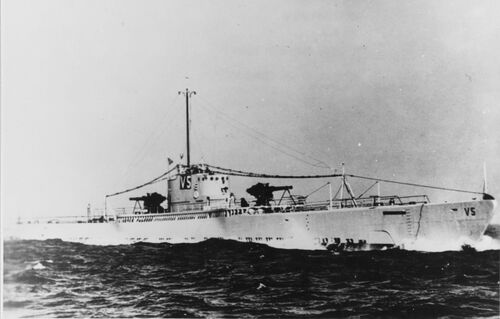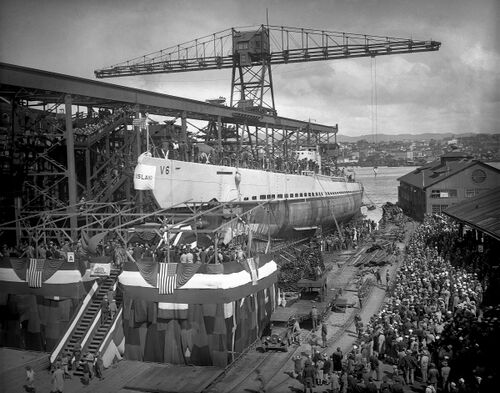V-5 and V-6: Difference between revisions
Pbcjohnston (talk | contribs) (Formatted page and added Notes section) |
Pbcjohnston (talk | contribs) (Rewrote design notes section) |
||
| (14 intermediate revisions by the same user not shown) | |||
| Line 1: | Line 1: | ||
[[File:Header 3 New.jpg | [[File:Header 3 New.jpg]] | ||
=== <big>Design and Construction Notes</big> === | === <big>Design and Construction Notes</big> === | ||
<div style="text-align: justify;"><span style="color:#00008B">The nine V-class fleet submarines were originally authorized in 1917, but construction did not start until well after the end of the Great War. By then, the concept of what the Navy wanted in a fleet submarine had changed numerous times. The Submarine Force came away very impressed with some of the long-range German cruiser U-boats that had been developed so the design for V-5 and V-6 morphed from a fleet support unit into that of a globe spanning commerce raider. This requirement dictated a very large boat to obtain the fuel bunkerage necessary for long range, and also a heavy gun armament to finish off merchantmen quickly. Consideration was given in the original concept to | <div style="text-align: justify;"><span style="color:#00008B">The nine V-class fleet submarines were originally authorized in 1917, but construction did not start until well after the end of the Great War. By then, the concept of what the Navy wanted in a fleet submarine had changed numerous times. The Submarine Force came away very impressed with some of the long-range German cruiser U-boats that had been developed so the design for V-5 and V-6 morphed from a fleet support unit into that of a globe spanning commerce raider. This requirement dictated a very large boat to obtain the fuel bunkerage necessary for long range, and also a heavy gun armament to finish off merchantmen quickly. Consideration was given in the original concept to include an aircraft hangar, but this idea was dropped after the very disappointing tests that had been conducted on the USS [[S-1|'''S-1 (SS-105)''']]. The final design closely mimiced the previous USS [[V-4|'''V-4 (SM-1)''']], but with the aft minelaying gear replaced by a after torpedo room with two tubes. The gun platforms for the two huge 6"/53 caliber Mk 17 guns were raised slightly from the V-4 design, and additional non-firing torpedo reload stowage tubes were mounted underneath the gun platforms. These boats, like the V-4 before them, were of [https://pigboats.icci.llc/images/3/37/NO_MORE_HEADS_OR_TAILS_TSR_version.pdf '''mostly riveted construction'''], but welding was used in certain non-critical areas such as support framing, pipe brackets, and deck joinery. V-5 was built at Portsmouth Navy Yard, but the V-6 construction was assigned to the Mare Island Navy Yard, the first submarine to be built from the keel up at that Vallejo, CA. based facility. | ||
These two boats were renamed Narwhal and Nautilus on February 19, 1931 and redesignated into the general submarine series later that year. | These two boats were renamed Narwhal and Nautilus on February 19, 1931 and redesignated into the general submarine series later that year. Along with their near sister [[V-4|'''Argonaut''']] they were frequent participants in fleet exercises in the 1930's, working the kinks out of the fleet submarine concept. | ||
Nautilus was refitted in 1941 to carry 19,320 gallons of aviation gasoline, in a scheme to use her to refuel long range sea planes. While the concept was tested briefly and judged successful, the Nautilus was not used in this capacity during the war. | |||
Both boats were refitted in 1941 and 1942 with four additional topside torpedo tubes, two forward and two aft, in an attempt to upgrade their firepower. These single shot tubes were not reloadable at sea and the weapons in them tended to be very unreliable due to the inability to perform maintenance on them at sea. The tubes were retained to the end of the war but were not popular with the crews. See the [[:Category:Submarine plans and blueprints|'''submarine plans and blueprints''']] page and the individual boat pages below for more information. | |||
Narwhal and Nautilus were underpowered and their great size and large decks made them slow divers and rather clumsy underwater. Despite these issues, they were moderately successful during the war, sinking a number of enemy ships. Thoroughly modernized, they served the Navy well as special mission submarines, their large size allowing them to land raiding parties and running supplies to guerilla groups in the Philippines and elsewhere. | |||
By the summer of 1945 they were thoroughly worn out and were sent back to the states for an honored retirement and decommissioning.</span></div> | By the summer of 1945 they were thoroughly worn out and were sent back to the states for an honored retirement and decommissioning.</span></div> | ||
| Line 11: | Line 17: | ||
=== <big>V-5/Narwhal (SC-1, later SS-167)</big> === | === <big>V-5/Narwhal (SC-1, later SS-167)</big> === | ||
[[File]] | [[File:V-5 starboard bow on trials NH 45652.jpg|left|500px|U.S. Navy photo NH 45652 courtesy of the NHHC.]] | ||
<div style="text-align: justify;"><span style="color:#00008B"> | <div style="text-align: justify;"><span style="color:#00008B">V-5 underway in a moderate sea, approximately summer 1930. She cut an imposing figure and was visually impressive. The location is not known. These long-range submarines required very long radio antenna wires in order to be able to communicate at great distances with the relatively low powered radio sets of the day. This accounts for the profusion of wires topside and the very tall raised radio mast.</span> | ||
[[167|See more V-5/Narwhal photos]] | |||
[[File:Red bar sub new 2.jpg]] | [[File:Red bar sub new 2.jpg]] | ||
=== <big>V-6/Nautilus (SC-2, later SS-168)</big> === | === <big>V-6/Nautilus (SC-2, later SS-168)</big> === | ||
[[File]] | [[File:Nautilus launch-1.jpg|left|500px|From an original glass plate negative in the private collection of Ric Hedman.]] | ||
<div style="text-align: justify;"><span style="color:#00008B"> | <div style="text-align: justify;"><span style="color:#00008B">V-6 about to slide down the ways at Mare Island Navy Yard, March 15, 1930. She would be renamed Nautilus just 11 months later.</span> | ||
[[168|See more V-6/Nautilus photos]] | |||
[[File:Red bar sub new 2.jpg]] | [[File:Red bar sub new 2.jpg]] | ||
Latest revision as of 12:40, 7 March 2024
Design and Construction Notes
These two boats were renamed Narwhal and Nautilus on February 19, 1931 and redesignated into the general submarine series later that year. Along with their near sister Argonaut they were frequent participants in fleet exercises in the 1930's, working the kinks out of the fleet submarine concept.
Nautilus was refitted in 1941 to carry 19,320 gallons of aviation gasoline, in a scheme to use her to refuel long range sea planes. While the concept was tested briefly and judged successful, the Nautilus was not used in this capacity during the war.
Both boats were refitted in 1941 and 1942 with four additional topside torpedo tubes, two forward and two aft, in an attempt to upgrade their firepower. These single shot tubes were not reloadable at sea and the weapons in them tended to be very unreliable due to the inability to perform maintenance on them at sea. The tubes were retained to the end of the war but were not popular with the crews. See the submarine plans and blueprints page and the individual boat pages below for more information.
Narwhal and Nautilus were underpowered and their great size and large decks made them slow divers and rather clumsy underwater. Despite these issues, they were moderately successful during the war, sinking a number of enemy ships. Thoroughly modernized, they served the Navy well as special mission submarines, their large size allowing them to land raiding parties and running supplies to guerilla groups in the Philippines and elsewhere.
By the summer of 1945 they were thoroughly worn out and were sent back to the states for an honored retirement and decommissioning.V-5/Narwhal (SC-1, later SS-167)

V-6/Nautilus (SC-2, later SS-168)

Page created by:
Ric Hedman & David Johnston
1999 - 2023 - PigBoats.COM©
Mountlake Terrace, WA, Norfolk, VA
webmaster at pigboats dot com
